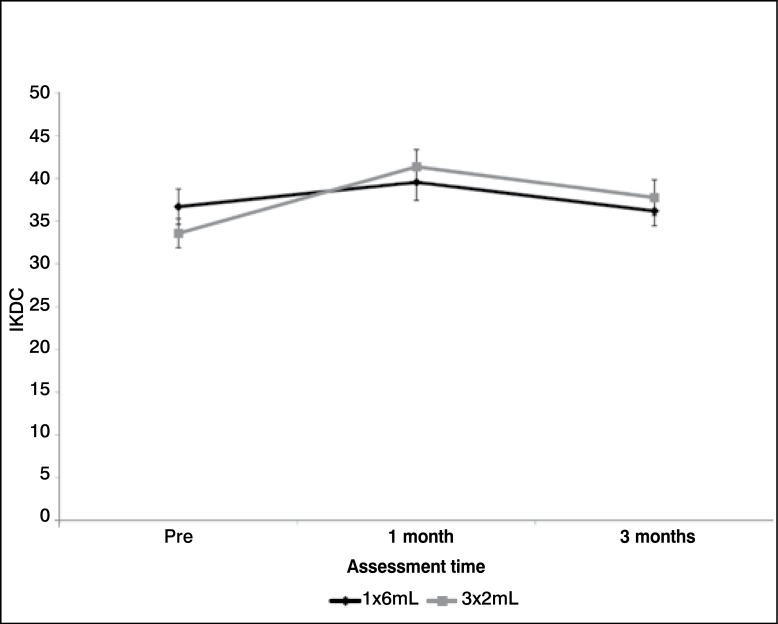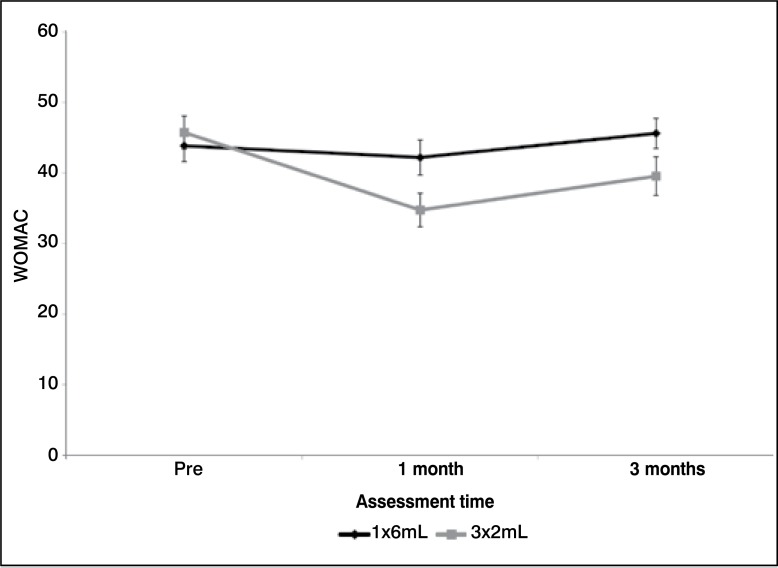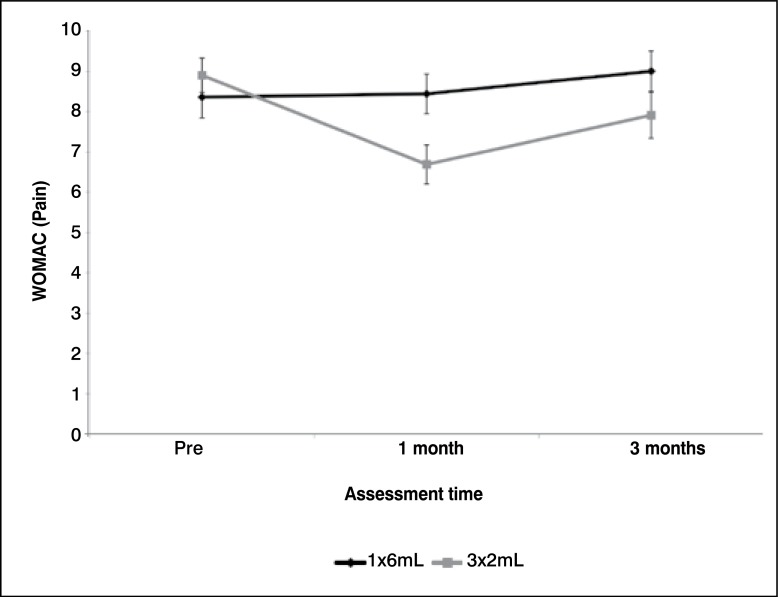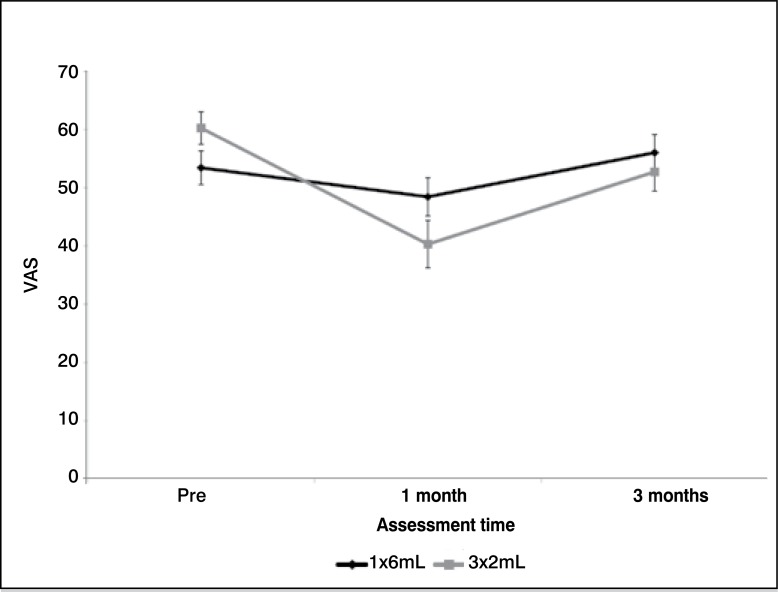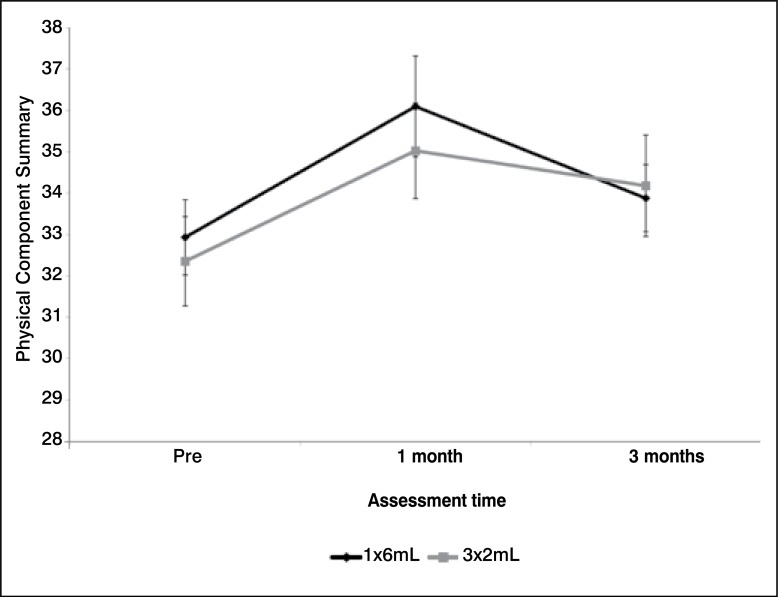Abstract
OBJECTIVE:
To compare two different dosages of an intermediate molecular weight sodium hyaluronate (HA) (Osteonil®-TRB Pharma) assessing whether a single 6 ml application of this HA has the same effectiveness as the classical three-weekly 2 ml dose.
METHODS:
108 patients with knee osteoarthritis were randomized into two groups of 54 patients each. The groups were designated "single" (S) and "weekly" (W). Patients in group S underwent a viscosupplementation procedure by application of only 6 ml of sodium hyaluronate and 1 ml triamcinolone hexacetonide. Patients in group W underwent the procedure of viscosupplementation through three applications with 2 ml sodium hyaluronate with a week interval between them, and the first application was also performed with the infiltration of 1 ml (20 mg) of Triamcinolone Hexacetonide. Both groups were assessed before, at one month and three months after application, by responding to the WOMAC, Lequesne, IKDC and VAS questionnaires.
RESULTS:
There was no statistical difference between the single application of 6 ml of sodium hyaluronate and classic application with three weekly injections. However, only the classical regime showed statistically significant improvement in baseline pain (WOMAC pain and VAS).
CONCLUSION:
Our results suggest that both application schemes improve application function, but the three-weekly regimen of 2 ml was more effective in reducing pain. Level of Evidence I, Prospective Randomized, Clinical Trial.
Keywords: Osteoarthritis, Knee, Hyaluronic acid/administration and dosage, Hyaluronic acid/therapeutic use
INTRODUCTION
Viscosupplementation (VS) is a relatively new intervention in the treatment of osteoarthritis (OA), currently recommended by the main therapeutic guidelines. 1 , 2 It is an intra-articular injection of sodium hyaluronate (HA, hyaluronic acid) in the diarthrodial joints aiming to improve pain and function 3 visco-induction 4 and to delay the disease progression. 5
VS has good short-term efficacy due to the analgesic effect of HA, 6 but it also has long-term action, with benefits in pain and function observed in the period of six months up to one year, 7 , 8 besides structural benefit. 9 , 10 As regards molecular weight, there are products considered "low weight", with molecular weight between 0.5 and 1x10 6 Daltons (Da), "high weight", with 6x10 6 Da, and "intermediate molecular weight", with molecular weight around 2x10 6 Da. 3
The best results of VS using low weight HA are observed with a dosage that ranges between three and five weekly applications, each with 2 to 2.5 ml of HA. 7 , 8 High molecular weight HA demonstrated efficacy with just one 6 ml application. 11 The single application is certainly more comfortable, especially considering the profile of patients with OA, who are generally elderly and often have impaired mobility. The aim of this study is to compare two different dosages of an intermediate molecular weight HA (Osteonil® -TRB Pharma), evaluating whether the single application of 6ml of this HA has the same efficacy as the classical regime of three weekly applications of 2 ml.
MATERIAL AND METHOD
This study was conducted in the Department of Orthopedics and Traumatology of the Institute of Orthopedics and Traumatology of Hospital das Clínicas da Faculdade de Medicina da Universidade de São Paulo (DOT-IOT-HCFMUSP), according to the guidelines of CONSORT (Consolidated Standards of Reporting Trials), and approved by the Commission of Ethics for Analysis of Research Projects (CAPPesq) under no. 0199/11. It is registered on the website clinicaltrials.org under nº. NCT01824485.
This prospective randomized clinical trial featured an evaluation of 108 patients diagnosed with OA of the knee(s), who were already in treatment in the metabolic disease group of IOT-HCFMUSP. Our habitual treatment consists of education through lessons, typed handouts, audiovisual material and guidance with orthopedists, nutritionist, psychologist, occupational therapist, physiotherapist, physical education teacher and social worker. All the patients, except for those with contraindications, make use of on-demand analgesics (paracetamol and codeine). According to knee alignment the use of insoles is also recommended. None of the patients makes routine use of non-hormonal anti-inflammatory agents, and their use was discouraged throughout the study, including in the seven-day period before the procedure.
Inclusion criteria:
-
•
Fulfill the diagnostic criteria for osteoarthritis of the American College of Rheumatology; 12
-
•
Understand, agree to and sign the informed consent form;
-
•
Absence of history of previous fracture in the knee to be studied;
-
•
Absence of history of previous surgery on the knee to be studied;
-
•
Absence of history of allergy to any of the substances used;
-
•
Not have performed any infiltration in the studied knee in the last 6 months;
-
•
Be in treatment in the group for at least six months;
-
•
Not have made use of non-hormonal anti-inflammatory agents in the last seven days.
Exclusion criteria:
-
•
Submit to surgery on the studied knee during the follow-up period;
-
•
Require further infiltration in the studied knee during the follow-up period - severe reaction to the procedure;
-
•
Development of active infection in the studied joint during the study;
-
•
Use non-hormonal anti-inflammatory agents at any time.
The informed consent form, visual analogue scale for pain (VAS) 13 and WOMAC, 14 IKDC and Lequesne questionnaires were applied one week before the infiltration. 15 The visual scale and the questionnaires were also answered one week (week 1), four weeks (week 4) and 12 weeks (week 12) after the infiltration. The AP+L radiographies were evaluated with load on the affected knee and the radiological grading was performed by three observers using the Kellgren-Lawrence classification. 16 In cases of disagreement (12 cases) the grade given by the majority was considered. There was no total disagreement in any case.
The patients were randomized in two groups of 54 patients each. The groups were designated "single" (S) and "weekly" (W). The patients from group S underwent a viscosupplementation procedure through a single application of 6 ml of HA and 1 ml triamcinolone hexacetonide in the arthritic knee. The patients from group W underwent a viscosupplementation procedure through three applications with 2 ml of HA in the arthritic knee, with a one-week interval between them, and the first application also involved the infiltration of 1 ml (20 mg) of triamcinolone hexacetonide.
All the procedures were carried out in an outpatient environment using the same technique. The knee infiltration was performed with the patient seated with their knees at a 90-degree angle and legs off the gurney. The approach chosen for the articular injection was anterolateral. 17 The procedures were executed by three investigators with experience in viscosupplementation. Soon after the procedure the patients were discharged without restrictions, with instructions to take 500 mg paracetamol every 6/6 hours for three days.
The sample group of patients was estimated calculating an n that would allow statistical power of 80% and significance level of 5%. The patients were allocated in two groups of 54 patients each (Groups S and W) through simple randomization generated by computer program, found on the website www.randomisation.com. The investigator who performed the randomization did not know the patients and did not take part in any intervention.
The three investigators who performed the infiltrations did not have contact with the patients at any other time. The investigators who applied the questionnaires, both at the pre-procedure time, and in the return appointments after one, four and 12 weeks, did not know which group the patients belonged to.
The side involvement and Kellgreen-Lawrence classification 16 were described according to groups with use of absolute and relative frequencies, verifying the existence of association of the side involvement and groups with use of the likelihood ratio test and comparing the degrees of Kellgreen and Lawrence classification 16 between the groups with use of Mann-Whitney tests. Kolmogorov-Smirnov Test for Normality for the probability distributions was applied to each scale assessed according to groups and assessment times, and there was no deviation from the assumption of distribution normality of the data.
The scales were described according to groups and assessment times with the use of means and standard deviations with the respective intervals with 95% of confidence for the means, comparing the scales between groups and times with the use of variance analyses with repeated measurements with two factors assuming a self-regressive correlation matrix of order 1 between times, followed by multiple Tukey comparisons to compare the groups and the times two by two.
RESULTS
The groups were statistically similar according to side involvement (p=0.710) and Kellgreen-Lawrence classification 16 on both sides (p>0.05). (Table 1) The groups also appeared homogeneous (p>0.05) in relation to the basal assessments. (Table 2). The results of the scales were illustrated with the use of average profile graphs with the respective intervals with 95% of confidence and the tests were conducted with significance level of 5%. (Figures 1 to 6)
Table 1. Description of the involvement side and Kellgreen & Lawrence classification according to groups and result of the statistical tests.
| Group | |||||||
|---|---|---|---|---|---|---|---|
| Variable | 1x6mL | 3x2mL | Total | p | |||
| N | % | N | % | N | % | ||
| Side | 0.710* | ||||||
| Right | 4 | 7.5 | 3 | 5.8 | 7 | 6.7 | |
| Left | 5 | 9.4 | 3 | 5.8 | 8 | 7.6 | |
| Bilateral | 44 | 83.0 | 46 | 88.5 | 90 | 85.7 | |
| Total | 53 | 100 | 52 | 100 | 105 | 100 | |
| Kellgreen & Lawrence's radiological classification of the R knee | 0.503** | ||||||
| I | 5 | 9.4 | 6 | 12.0 | 11 | 10.7 | |
| II | 22 | 41.5 | 24 | 48.0 | 46 | 44.7 | |
| III | 20 | 37.7 | 13 | 26.0 | 33 | 32.0 | |
| IV | 6 | 11.3 | 7 | 14.0 | 13 | 12.6 | |
| Total | 53 | 100 | 50 | 100 | 103 | 100 | |
| Kellgreen & Lawrence's radiological classification of the L knee | 0.487** | ||||||
| I | 6 | 11.5 | 3 | 5.8 | 9 | 8.7 | |
| II | 22 | 42.3 | 30 | 57.7 | 52 | 50.0 | |
| III | 15 | 28.8 | 14 | 26.9 | 29 | 27.9 | |
| IV | 9 | 17.3 | 5 | 9.6 | 14 | 13.5 | |
| Total | 52 | 100 | 52 | 100 | 104 | 100 | |
Result of the likelihood ratio test
Result of the Mann-Whitney test
Table 2. Description of the scales according to groups and times assessed.
| 1x6mL | 3x2mL | ||||||||||
|---|---|---|---|---|---|---|---|---|---|---|---|
| Variable | Time | Mean | SD | CI (95%) | N | Mean | SD | CI (95%) | N | ||
| Lower | Upper | Lower | Upper | ||||||||
| IKDC | Pre | 36.68 | 15.05 | 32.6 | 40.7 | 53 | 33.58 | 12.32 | 30.2 | 36.9 | 52 |
| 1 month | 39.54 | 14.72 | 35.4 | 43.7 | 48 | 41.35 | 13.88 | 37.4 | 45.3 | 48 | |
| 3 months | 36.18 | 12.03 | 32.8 | 39.5 | 49 | 37.75 | 14.29 | 33.7 | 41.8 | 47 | |
| WOMAC | Pre | 43.83 | 16.30 | 39.4 | 48.2 | 53 | 45.71 | 16.84 | 41.1 | 50.3 | 52 |
| 1 month | 42.17 | 17.08 | 37.3 | 47.0 | 48 | 34.73 | 16.43 | 30.1 | 39.4 | 48 | |
| 3 months | 45.59 | 14.93 | 41.4 | 49.8 | 49 | 39.53 | 18.77 | 34.2 | 44.9 | 47 | |
| WOMAC (Pain) | Pre | 8.36 | 3.78 | 7.3 | 9.4 | 53 | 8.90 | 3.08 | 8.1 | 9.7 | 52 |
| 1 month | 8.44 | 3.41 | 7.5 | 9.4 | 48 | 6.69 | 3.35 | 5.7 | 7.6 | 48 | |
| 3 months | 9.00 | 3.51 | 8.0 | 10.0 | 49 | 7.91 | 3.91 | 6.8 | 9.0 | 47 | |
| VAS | Pre | 53.43 | 21.07 | 47.8 | 59.1 | 53 | 60.25 | 20.12 | 54.8 | 65.7 | 52 |
| 1 month | 48.43 | 22.66 | 42.0 | 54.8 | 48 | 40.30 | 28.18 | 32.3 | 48.3 | 48 | |
| 3 months | 56.02 | 21.86 | 49.9 | 62.1 | 49 | 52.73 | 22.82 | 46.2 | 59.3 | 47 | |
| Lequesne | Pre | 12.15 | 3.54 | 11.2 | 13.1 | 53 | 11.93 | 3.61 | 11.0 | 12.9 | 52 |
| 1 month | 10.68 | 3.89 | 9.6 | 11.8 | 48 | 10.37 | 4.35 | 9.1 | 11.6 | 48 | |
| 3 months | 11.99 | 3.83 | 10.9 | 13.1 | 49 | 11.40 | 4.37 | 10.2 | 12.7 | 47 | |
| PCS | Pre | 32.93 | 6.63 | 31.1 | 34.7 | 53 | 32.35 | 7.76 | 30.2 | 34.5 | 52 |
| 1 month | 36.10 | 8.43 | 33.7 | 38.5 | 48 | 35.03 | 8.00 | 32.8 | 37.3 | 48 | |
| 3 months | 33.88 | 5.61 | 32.3 | 35.5 | 48 | 34.18 | 8.40 | 31.8 | 36.6 | 47 | |
| MCS | Pre | 46,30 | 10,85 | 43,4 | 49,2 | 53 | 48,23 | 12,71 | 44,8 | 51,7 | 52 |
| 1 month | 45,06 | 11,93 | 41,7 | 48,4 | 48 | 47,02 | 13,89 | 43,1 | 50,9 | 48 | |
| 3 months | 47,35 | 11,72 | 44,0 | 50,7 | 48 | 46,72 | 11,03 | 43,6 | 49,9 | 47 | |
Figure 1. Mean profiles and respective standard errors of the IKDC questionnaire according to groups.
Figure 1 suggests an increase (improvement) in IKDC after one month in both groups and a small reduction after three months. Only the group that received the weekly application (W Group) presented an improvement in the WOMAC questionnaires and their pain subscale (WOMAC pain) over the course of treatment, particularly during the first month. (Table 3, Figures 2 and 3) Even though there was a statistically significant reduction in this group only (p<0.001), it was not possible to differentiate between the groups in relation to the WOMAC and WOMAC pain scales at any time (p>0.05).
Table 3. Result of the multiple comparisons of the WOMAC scale between groups and times.
| Group/ Time | Comparison | Mean difference | Standard error | t value | GL | p |
|---|---|---|---|---|---|---|
| 1x6mL | Pr-1 month | 2.81 | 2.20 | 1.28 | 188 | 0.797 |
| Pre-3 months | -1.06 | 2.73 | -0.39 | 188 | 0.999 | |
| 1 month-3 months | -3.86 | 2.24 | -1.73 | 188 | 0.517 | |
| 3x2mL | Pré-1 month | 11.09 | 2.21 | 5.03 | 188 | <0.001 |
| Pre-3 months | 6.40 | 2.77 | 2.31 | 188 | 0.197 | |
| 1 month-3 months | -4.69 | 2.27 | -2.07 | 188 | 0.308 | |
| Pre | 1x6mL-3x2mL | -1.88 | 3.28 | -0.57 | 188 | 0.993 |
| 1 month | 1x6mL-3x2mL | 6.40 | 3.37 | 1.90 | 188 | 0.405 |
| 3 months | 1x6mL-3x2mL | 5.57 | 3.39 | 1.64 | 188 | 0.572 |
Figure 2. Mean profiles and respective standard errors of the WOMAC questionnaire according to groups.
Figure 3. Mean profiles and respective standard errors of the WOMAC Pain questionnaire according to groups.
Table 4 shows that the visual analogue scale for pain (VAS) presented reduction in both groups, (Figure 4) with a statistical decrease from pre-procedure to one month only in the group that received fractionated application (Group W) (p<0.001). At no time was there any statistically significant difference in the mean values of pain between the groups (p>0.05).
Table 4. Result of the multiple comparisons of the VAS scale between groups and times.
| Group/ Time | Comparison | Mean difference | Standard error | t value | GL | p |
|---|---|---|---|---|---|---|
| 1x6mL | Pre-1 month | 6.61 | 3.45 | 1.92 | 188 | 0.396 |
| Pre-3 months | -1.96 | 4.08 | -0.48 | 188 | 0.997 | |
| 1 month-3 months | -8.58 | 3.52 | -2.44 | 188 | 0.149 | |
| 3x2mL | Pre-1 month | 19.79 | 3.46 | 5.71 | 188 | <0.001 |
| Pre-3 months | 7.62 | 4.15 | 1.84 | 188 | 0.444 | |
| 1 month-3 months | -12.17 | 3.56 | -3.42 | 188 | 0.010 | |
| Pre | 1x6mL-3x2mL | -6.82 | 4.45 | -1.53 | 188 | 0.643 |
| 1 month | 1x6mL-3x2mL | 6.36 | 4.60 | 1.38 | 188 | 0.737 |
| 3 months | 1x6mL-3x2mL | 2.77 | 4.63 | 0.60 | 188 | 0.991 |
Figure 4. Mean profiles and respective standard errors of the VAS scale according to groups.
Figure 5 shows that both groups reduce the score of the Lequesne questionnaire after one month, with return close to the initial value after three months. Judging by Figure 6, both groups present an increase (improvement) in the physical component (PCS) of the SF-36 quality of life questionnaire.
Figure 5. Mean profiles and respective standard errors of the Lequesne score according to groups.
Figure 6. Mean profiles and respective standard errors of the physical component (PCS) of the SF-36 quality of life questionnaire according to groups.
In short, there was no statistical difference between the single application of 6 ml of sodium hyaluronate and the classical application with three weekly injections. However, only the classical regime demonstrated statistically significant improvement in relation to the basal values of pain (WOMAC pain and VAS)
DISCUSSION
Viscosupplementation continues to be a controversial treatment for knee osteoarthritis, due either to the late start of symptomatic and functional improvement, or the existence of different products with different application regimes. The literature still presents considerably heterogeneous results. 7 , 8 This is the first national study to assess the efficacy of an intermediate molecular weight HA (Osteonil®-TRB Pharma), comparing the classical application regime (three weekly applications) with the single application regime, already used in products of higher molecular weight. 11
This study presents some limitations. Firstly, despite limiting the use of NSAIDs, we did not limit the use of analgesics or any other non-pharmacological treatment, as we believe that viscosupplementation should not be the sole treatment in OA. Therefore, the patients continued to receive the "habitual treatment" and were instructed to keep a diary with the use of analgesics, which did not show any difference between the groups. Secondly, clinical questionnaires such as WOMAC and Lequesne do not distinguish one knee from the other when the patient presents bilateral arthrosis. For this reason, in cases of bilateral disease, we treat both knees with the same application regime but only the knee indicated as "worse" by the patient was considered. Thirdly, we did not have a placebo-controlled group. This is a non-inferiority study, i.e., our goal was to evaluate whether we would find the same results obtained with the classical application regime through the single application regime.
In this study we added 1 ml of triamcinolone hexacetonide to the first dosage in both groups. The addition of corticosteroids improves the short-term results of VS, without altering the adverse effects or the long-term results, 18 and is therefore standard in our service.
Both groups exhibited an improvement after viscosupplementation, particularly in the first month. There was no statistical difference between the groups at any time. However, only the group submitted to the classical application regime (Group W) presented statistically significant improvement in the WOMAC, WOMAC pain and VAS questionnaires. The weekly application regime therefore exhibited superior analgesia in comparison to the single application regime. This was probably due to the length of time the drug remains in the joint. The symptomatic and structural benefit promoted by viscosupplementation is obtained with a single treatment cycle, either composed of three to five weekly applications, as in the majority of hyaluronates, or through a single application, in the case of hylan. Therefore, the joint-drug contact duration will be able to define the magnitude of the changes promoted by this drug. It is known that the half-life of hyaluronate in the joint is 13 hours, which leads to a length of permanence of around seven days in the joint. 19 Thus three to five weekly applications produce a joint-drug contact time between 21 and 35 days. Today the only drug whose single application is recommended presents intra-articular half-life of eight days, with continued presence in the joint for around 40 days. 20 It is probably due to this reason that the use of intermediate molecular weight hyaluronate in a single dosage cannot promote sufficient time of contact of the drug with the joint. Accordingly, it is possible to speculate that a treatment with five weekly applications could produce an even better result. Further studies on this subject are necessary.
CONCLUSION
Our results suggest that both application regimes improve function, but the regime of 3 weekly applications of 2 ml was more efficient at improving pain.
Acknowledgments
ACKNOWLEDGEMENTS
The authors are grateful to the TRB Pharma laboratory for having donated the medications used in this study.
Footnotes
Acta Ortop Bras. [online]. 2013;21(5): 271-5. Available from URL: http://www.scielo.br/aob.
Work performed at Group of Osteometabolic and Degenerative Diseases of the Institute of Orthopedics and Traumatology of Hospital das Clínicas da Faculdade de Medicina da Universidade de São Paulo, São Paulo, SP, Brazil.
REFERENCES
- 1.Zhang W, Nuki G, Moskowitz RW, Abramson S, Altman RD, Arden NK, et al. OARSI recommendations for the management of hip and knee osteoarthritis: part III: Changes in evidence following systematic cumulative update of research published through January 2009. Osteoarthritis Cartilage. 2010;18(4):476–499. doi: 10.1016/j.joca.2010.01.013. [DOI] [PubMed] [Google Scholar]
- 2.Hochberg MC, Altman RD, April KT, Benkhalti M, Guyatt G, McGowan J, et al. American College of Rheumatology 2012 recommendations for the use of nonpharmacologic and pharmacologic therapies in osteoarthritis of the hand, hip, and knee. Arthritis Care Res (Hoboken). 2012;64(4):455–474. doi: 10.1002/acr.21596. [DOI] [PubMed] [Google Scholar]
- 3.Rezende MU, Campos GC. Viscosuplementação. Rev Bras Ortop. 2012;47(2):158–162. [Google Scholar]
- 4.Smith MM, Ghosh P. The synthesis of hyaluronic acid by human synovial fibroblasts is influenced by the nature of the hyaluronate in the extracellular environment. Rheumatol Int. 1987;7(3):113–122. doi: 10.1007/BF00270463. [DOI] [PubMed] [Google Scholar]
- 5.Jubb RW, Piva S, Beinat L, Dacre J, Gishen P. A one-year, randomised, placebo (saline) controlled clinical trial of 500-730 kDa sodium hyaluronate (Hyalgan) on the radiological change in osteoarthritis of the knee. Int J Clin Pract. 2003;57(6):467–474. [PubMed] [Google Scholar]
- 6.Gomis A, Miralles A, Schmidt RF, Belmonte C. Intra-articular injections of hyaluronan solutions of different elastoviscosity reduce nociceptive nerve activity in a model of osteoarthritic knee joint of the guinea pig. Osteoarthritis Cartilage. 2009;17(6):798–804. doi: 10.1016/j.joca.2008.11.013. [DOI] [PubMed] [Google Scholar]
- 7.Bellamy N, Campbell J, Robinson V, Gee T, Bourne R, Wells G. Viscosupplementation for the treatment of osteoarthritis of the knee. Cochrane Database Syst Rev. 2006;(2):CD005321–CD005321. doi: 10.1002/14651858.CD005321.pub2. [DOI] [PMC free article] [PubMed] [Google Scholar]
- 8.Bannuru RR, Natov NS, Dasi UR, Schmid CH, McAlindon TE. Therapeutic trajectory following intra-articular hyaluronic acid injection in knee osteoarthritis-meta-analysis. Osteoarthritis Cartilage. 2011;19(6):611–619. doi: 10.1016/j.joca.2010.09.014. [DOI] [PubMed] [Google Scholar]
- 9.Guidolin DD, Ronchetti IP, Lini E, Guerra D, Frizziero L. Morphological analysis of articular cartilage biopsies from a randomized, clinical study comparing the effects of 500-730 kDa sodium hyaluronate (Hyalgan) and methylprednisolone acetate on primary osteoarthritis of the knee. Osteoarthritis Cartilage. 2001;9(4):371–381. doi: 10.1053/joca.2000.0398. [DOI] [PubMed] [Google Scholar]
- 10.Listrat V, Ayral X, Patarnello F, Bonvarlet JP, Simonnet J, Amor B, et al. Arthroscopic evaluation of potential structure modifying activity of hyaluronan (Hyalgan) in osteoarthritis of the knee. Osteoarthritis Cartilage. 1997;5(3):153–160. doi: 10.1016/s1063-4584(97)80010-6. [DOI] [PubMed] [Google Scholar]
- 11.Chevalier X, Jerosch J, Goupille P, van Dijk N, Luyten FP, Scott DL, et al. Single, intra-articular treatment with 6 ml hylan G-F 20 in patients with symptomatic primary osteoarthritis of the knee: a randomised, multicentre, double-blind, placebo controlled trial. Ann Rheum Dis. 2010;69(1):113–119. doi: 10.1136/ard.2008.094623. [DOI] [PMC free article] [PubMed] [Google Scholar]
- 12.Altman R, Asch E, Bloch D, Bole G, Borenstein D, Brandt K, et al. Development of criteria for the classification and reporting of osteoarthritis. Classification of osteoarthritis of the knee. Diagnostic and Therapeutic Criteria Committee of the American Rheumatism Association. Arthritis Rheum. 1986;29(8):1039–1049. doi: 10.1002/art.1780290816. [DOI] [PubMed] [Google Scholar]
- 13.Carlsson AM. Assessment of chronic pain. I. Aspects of the reliability and validity of the visual analogue scale. Pain. 1983;16(1):87–101. doi: 10.1016/0304-3959(83)90088-X. [DOI] [PubMed] [Google Scholar]
- 14.Fernandes MI. Tradução e validação do questionário de qualidade de vida específico para osteoartrose WOMAC (Western Ontario McMaster Universities) para a língua portuguesa. São Paulo: Universidade Federal de São Paulo; 2003. [Google Scholar]
- 15.Marx FC, Oliveira LM, Bellini CG, Ribeiro MCC. Tradução e validação cultural do questionário algofuncional de Lequesne para osteoartrite de joelhos e quadris para a língua portuguesa. Rev Bras Reumatol. 2006;46(4):253–260. [Google Scholar]
- 16.Kellgren JH, Lawrence JS. Radiological assessment of rheumatoid arthritis. Ann Rheum Dis. 1957;16(4):485–493. doi: 10.1136/ard.16.4.485. [DOI] [PMC free article] [PubMed] [Google Scholar]
- 17.Esenyel C, Demirhan M, Esenyel M, Sonmez M, Kahraman S, Senel B, et al. Comparison of four different intra-articular injection sites in the knee: a cadaver study. Knee Surg Sports Traumatol Arthrosc. 2007;15(5):573–577. doi: 10.1007/s00167-006-0231-6. [DOI] [PubMed] [Google Scholar]
- 18.de Campos GC, Rezende MU, Pailo AF, Frucchi R, Camargo OP. Adding triamcinolone improves viscosupplementation: a randomized clinical trial. Clin Orthop Relat Res. 2013;471(2):613–620. doi: 10.1007/s11999-012-2659-y. [DOI] [PMC free article] [PubMed] [Google Scholar]
- 19.Brandt KD, Smith GN, Jr., Simon LS. Intraarticular injection of hyaluronan as treatment for knee osteoarthritis: what is the evidence? Arthritis Rheum. 2000;43(6):1192–1203. doi: 10.1002/1529-0131(200006)43:6<1192::AID-ANR2>3.0.CO;2-L. [DOI] [PubMed] [Google Scholar]
- 20.Jackson DW, Simon TM. Intra-articular distribution and residence time of Hylan A and B: a study in the goat knee. Osteoarthritis Cartilage. 2006;14(12):1248–1257. doi: 10.1016/j.joca.2006.05.015. [DOI] [PubMed] [Google Scholar]



